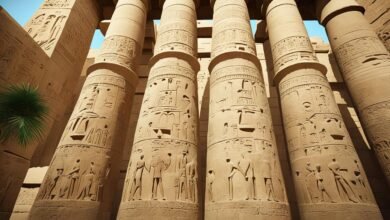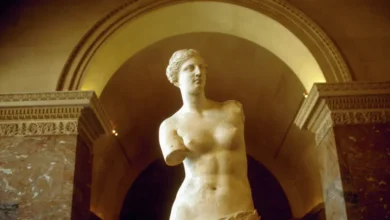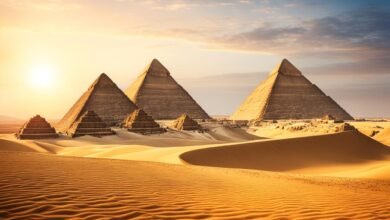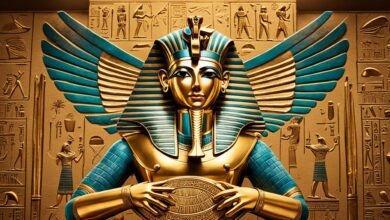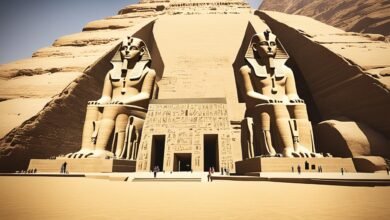In the heart of northeastern Africa lies ancient Egypt, a cradle of civilization. It stands as a tribute to human creativity, yet remains a mystery. From its grand pyramids and vast deserts, its legacy calls us to discover its secrets and ponder timeless questions.
Have you ever wondered how the ancient Egyptians built structures that still stand today? Or how they created a society that shaped our history? What stories do their rich tombs and detailed hieroglyphics hide?
Join us as we explore the ancient Egyptian world. We will shine a light on their rich history and cultural achievements. Through this exploration, we aim to understand a civilization that continues to influence us today.

The Pharaohs: Divine Architects of Civilization
The ancient Egyptian pharaohs were seen as half-gods. They were the key figures of their society. Their pyramids were much more than tombs. They were designed to connect the heavens and earth. The Great Pyramids of Giza, in particular, show the pharaohs' desire to live forever. They also show their power over Egypt.
For a long time, the pharaohs ruled Egypt with total control. People believed that the gods chose them to lead. The pharaohs' rule was full of grand ceremonies and was deeply connected to religion.
Building the pyramids was a way for pharaohs to live forever in the afterlife. The massive structures were made intricately. They show the cleverness and skill of ancient Egyptian engineers. These buildings were meant to be the eternal homes of the pharaohs.
The Great Pyramids of Giza are dedicated to pharaohs Khufu, Khafre, and Menkaure. These structures are amazing examples of ancient architecture. The Great Pyramid of Khufu, the biggest one, is a true wonder. It shows the pharaohs' strong will and their link to the divine.
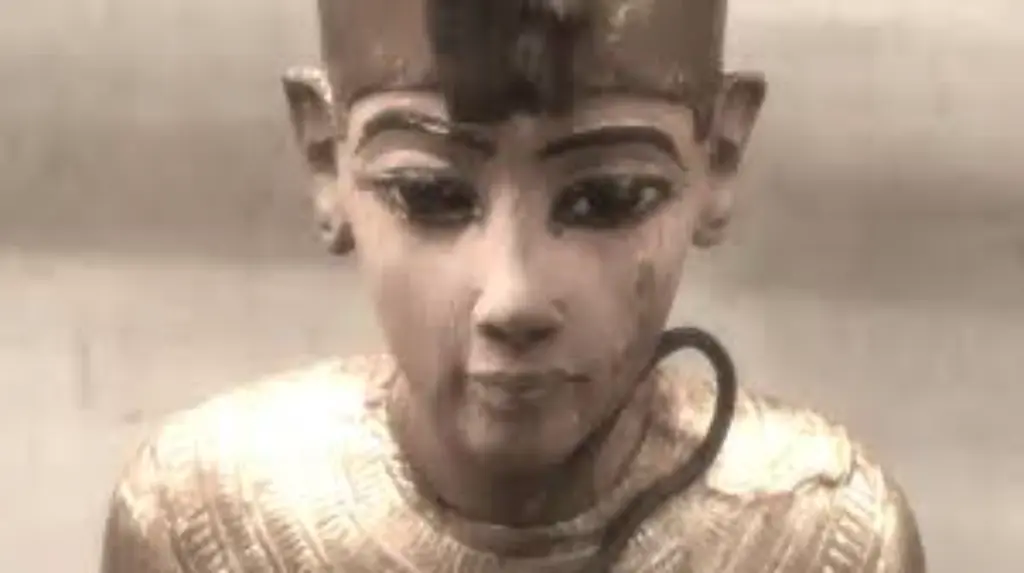
The pharaohs made a lasting impact on Egypt's history. Their rule was known as a time of great wealth, art, and achievements. They pushed the limits of what was possible. Even after their deaths, the pharaohs continued to shape Egypt and the world.
The Great Pyramids of Giza: Enigmatic Wonders of the Ancient World
| Name | Location | Height (in meters) |
|---|---|---|
| Great Pyramid of Khufu | Giza | 146.6 |
| Great Pyramid of Khafre | Giza | 136.4 |
| Great Pyramid of Menkaure | Giza | 65.5 |
The Great Pyramids of Giza are near Cairo. They still amaze people all over the world. The pyramids show the pharaohs' divine power. They are unforgettable symbols of history and mystery.
The Nile: Lifeblood of a Civilization
The ancient Egyptian civilization owes a lot to the Nile River. This amazing waterway flooded predictably, helping to create a thriving society. It was the heart of their civilization, offering key resources and supporting great accomplishments.
The Nile River is over 4,000 miles long and flows through dry desert. It creates a lush space where agriculture can thrive. Its yearly flood brings life-giving silt that makes the land perfect for growing crops. This ensured there was always enough food and even extra to trade, leading to an advanced society.
The Nile's location made it perfect for trade and travel. It connected different parts of Egypt and other lands. This made it a key path for moving goods and people. It helped the Egyptians share their culture and grow economically.
The Nile was also deeply important to the Egyptians in a spiritual way. They saw it as a god, linking it to life, death, and rebirth. The rhythm of its floods represented the cycle of life, showing how life always starts again.
They believed their gods were in charge of the Nile, giving them good harvests and a strong society.
To wrap up, the Nile River was critical to the ancient Egyptian community. It was their source of life, wealth, and spiritual beliefs. It transformed a desert into a thriving land. Even now, the Nile's story teaches us about the cleverness and strength of ancient Egyptians.
The Mystique of the Sphinx and the Pyramids
The Great Sphinx of Giza is a true mystery. It has the body of a lion and a pharaoh's head. Recent studies show the Sphinx, like the pyramids, may have begun from nature's work. But later, humans shaped it. This mix of natural and human creation shows how deeply the ancient Egyptians were connected to their land. It also tells about their great skill in blending nature into their beliefs and culture.
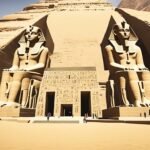 Uncover the Secrets of the Great Sphinx of Giza
Uncover the Secrets of the Great Sphinx of Giza
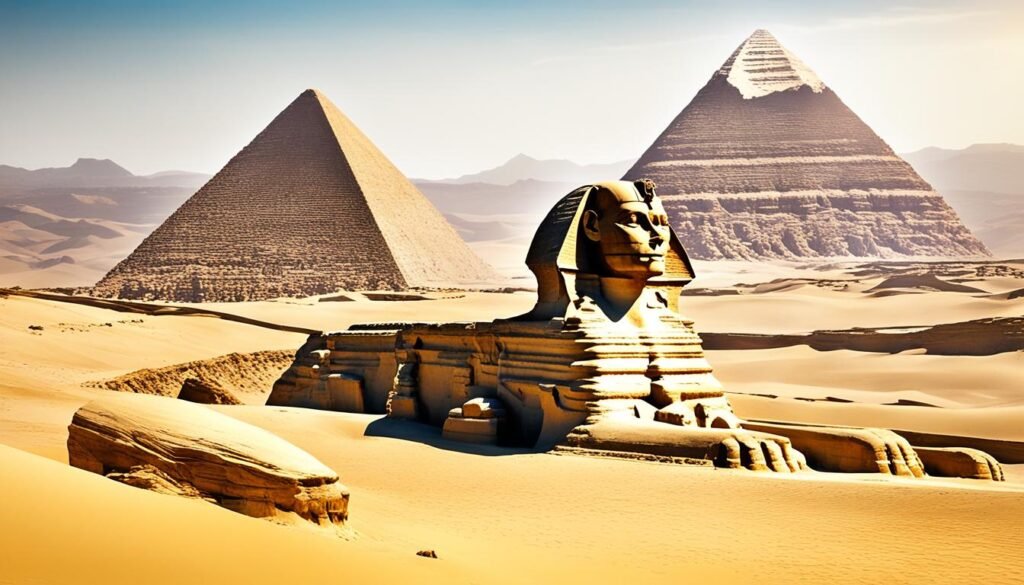
A Society Ahead of Its Time
Ancient Egyptian society was ahead of its time. It excelled in many areas, outshining others. Their achievements in agriculture, architecture, and technology are legendary.
The ancient Egyptians built the pyramids, which are still wonders today. The Great Pyramid of Giza shows their engineering genius. It also reflects their amazing ability to organize and work together. These pyramids, big tombs for the pharaohs, are marvels of precision and grandeur.
They also created complex writing systems. These systems, including hieroglyphics and hieratic scripts, told their stories. They recorded their history, beliefs, and daily activities. This writing provides a unique insight into their culture and offers clues to their deep wisdom.
Ancient Egyptian agriculture was cutting-edge. They innovated to get the most out of their crops. The annual Nile floods provided fertile soil. They used smart irrigation and crop rotation to feed their people well. This innovation kept their society strong.
The ancient Egyptians were far ahead in technology. They had tools and techniques that others didn't. Their craftsmanship is evident in their temples, tombs, and jewelry. All these show their technical mastery and skill.
Achievements of Ancient Egyptian Society:
- Advanced engineering and construction of the pyramids
- Innovative agricultural techniques
- Intricate writing systems: hieroglyphics and hieratic
- Technological advancements in various fields
The ancient Egyptians achieved incredible feats. From their building wonders to technological advancements, they left a lasting impact. Their accomplishments highlight their remarkable creativity and vision.
Echoes of Immortality: The Afterlife and Mummification
The Egyptians' view of the afterlife and mummification show how much they understood life's end. Their complex beliefs led to detailed burial ceremonies and mummification.
They believed death was a start of a new life. For them, the soul, called the “ka,” kept moving after the body died. Preserving the body was key to this journey, and mummification was their method.
Mummification was seen as a holy and intricate art. It included taking out organs, drying the body with natron, and wrapping it up. Only those trained, often priests, did this work.
Mummies weren't just for kings or the rich. Everyone could choose to mummify themselves. They were laid in beautiful coffins with special burial masks.
This was meant to continue life in the next world. Inside their tombs, they placed items the dead loved. These were to help the dead in the afterlife.
The care they put into burial showed their strong belief in life after death. These rituals and burials were central to their culture. They symbolized the bond between the living and the dead, searching for forever together.
The Legacy of Ancient Egypt
Ancient Egypt still dazzles and intrigues us today. The found tomb of Tutankhamun, the unsolved pyramid mystery, and ongoing digs all show how complex Egypt was. It's a symbol of what humans can achieve and a question about our past and future.
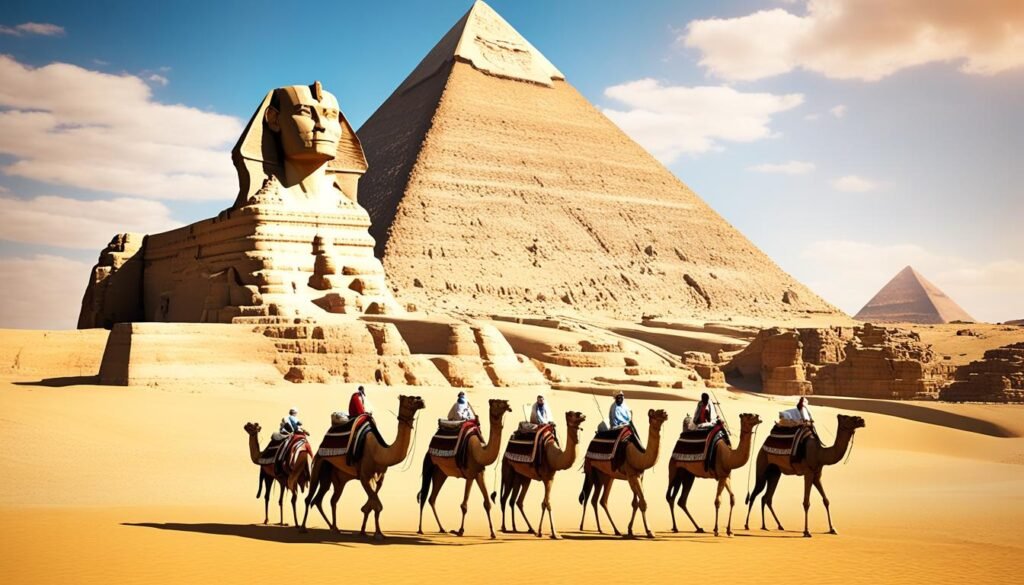
Ancient Egyptian Art: A Window Into the Past
The art of ancient Egypt is a treasure with its detailed writing and lively scenes. It lets us see into their beliefs and daily life. Whether found in tombs or on temple walls, it shows their skill and respect for the divine. Sculptures, jewelry, pottery, and textiles prove the talent and innovation of these long-ago artists.
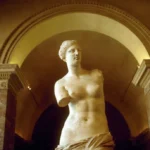 Uncover the Mysteries of Venus de Milo Sculpture
Uncover the Mysteries of Venus de Milo Sculpture
The Cultural Tapestry of Ancient Egypt
Egypt's culture was a mix thanks to its location and ties with other lands. The Nile River was vital, helping trade and sharing of ideas. This helped make Egypt's unique ways, from religion and language to how they built and even cooked.
| Aspect | Key Features |
|---|---|
| Religion | The ancient Egyptians had a complex pantheon of gods and goddesses, with each deity associated with specific aspects of life. They practiced elaborate rituals and believed in an afterlife. |
| Language | The ancient Egyptians developed hieroglyphics, a system of writing that combined phonetic, ideographic, and determinative elements. Hieratic script was a cursive form used for everyday purposes, while demotic script emerged later and was used for administrative and business purposes. |
| Architecture | The Egyptians were renowned for their construction of monumental structures such as pyramids, temples, and tombs. They employed precise mathematical calculations and engineering techniques to create lasting architectural marvels. |
| Music and Dance | Ancient Egyptian music and dance were integral to their religious ceremonies and celebrations. Instruments such as flutes, harps, and drums were played, accompanied by rhythmic movements and gestures. |
| Clothing and Fashion | Ancient Egyptians wore garments made from linen, a fabric derived from the flax plant. The styles of clothing varied based on social status and gender, with elaborate jewelry and accessories enhancing their attire. |
The Enduring Influence of Ancient Egypt
Ancient Egypt's influence reaches throughout time and the world. Their knowledge benefited other societies. – Ancient Greek scholars, for instance, learned from Egyptian advances. Today, we're still enchanted by Egypt and its deep reflections on being human.
The Mighty Pharaohs
Pharaohs were the powerful rulers of ancient Egypt. They were seen as gods by their people. They connected the world of the gods with regular life on Earth. This role was key in making the Egyptian culture what it became over time.
Cleopatra
Cleopatra was the last queen of Egypt, from Macedonian Greek roots. She was famous for her looks and charm. She made friends with Julius Caesar and later, Mark Antony. These friendships shaped the events of their time.
King Tutankhamun
King Tut, as he is often known, became a pharaoh when he was only nine years old. Although he ruled for a short time, his tomb was full of treasures. These findings helped us understand more about ancient Egypt.
Hatshepsut
Hatshepsut was a remarkable woman who became pharaoh. To be taken seriously in a man's world, she dressed like a man and had herself invoiced with male titles. Her time as a pharaoh was marked by peace and stunning construction projects like the Temple of Deir el-Bahari.
Ramses II
Ramses II, also called Ramses the Great, stood out among Egypt's pharaohs. He ruled for 66 years, making a huge impact. Ramses II is known for his building projects, military strength, and successful diplomacy. He helped make Egypt powerful during his reign.
Studying these pharaohs helps us see the grand and complex nature of ancient Egypt. Their rule, effects, and gifts to Egypt still capture our interest and inspiration today.
The Enigmatic Pyramids
The ancient Egyptian pyramids are incredible signs of a great civilization along the Nile. The Great Pyramid of Giza is the most famous. It was built for Pharaoh Khufu during the Old Kingdom. These mysterious structures still amaze people today.
The Pyramids of Giza are aligned with Orion's Belt in the sky, which is fascinating. This shows the ancient Egyptians' deep connection to the stars. Their spiritual beliefs and ties to the universe are clear.
Building the pyramids took lots of planning and special engineering skills. They used ramps, pulleys, and many workers. The Egyptians paid close attention to every detail. Their work shows incredible architectural skill.
The pyramids were not just monuments. They were also grand tombs for the pharaohs. These structures honored the pharaohs' lives and beliefs in the afterlife. They were filled with treasures and special rituals.
The pyramids' shape and design reflect ancient Egyptian religious beliefs. The pyramid shape symbolized the pharaoh's journey to the heavens. It also signifies their transformation into a god-like being. This is a unique perspective into how they saw the afterlife.
Standing before the Egyptian pyramids, we see human creativity at its best. These monuments show the lasting impact of the Egyptian civilization. They inspire us in art, architecture, and history.
Ancient Egyptian Medicine: An Integrated Approach to Healing
Ancient Egypt linked medicine closely with religious beliefs. They thought evil spirits caused sicknesses. So, they turned to gods for help. The doctors, called “swnw,” were held in high regard. They learned their skills in special schools.
Doctors in Ancient Egypt believed in both physical and spiritual cures. They mixed what they saw with what they knew, adding some magic. This helped them understand and tackle diseases. Pharma was a key tool for them, using various plants for cures.
 Explore the Mysteries of the Pyramids of Giza
Explore the Mysteries of the Pyramids of Giza
Egyptian surgeons were quite skilled, doing things like removing limbs and helping with broken bones. They even tried early brain surgery. Not bad for the olden days, especially without all our modern gadgets.
Source Links
- https://medium.com/@abodoniakaram777/unveiling-the-secrets-of-ancient-egypt-1-000-fascinating-facts-62d1a6caf05d
- https://medium.com/@simohamed.amara/unveiling-the-eternal-mysteries-of-ancient-egypt-beyond-the-sands-of-time-e590313953b5
- https://hogghistory.org/education-blog/ancient-egyptian-medicine-secrets-nile-valley
